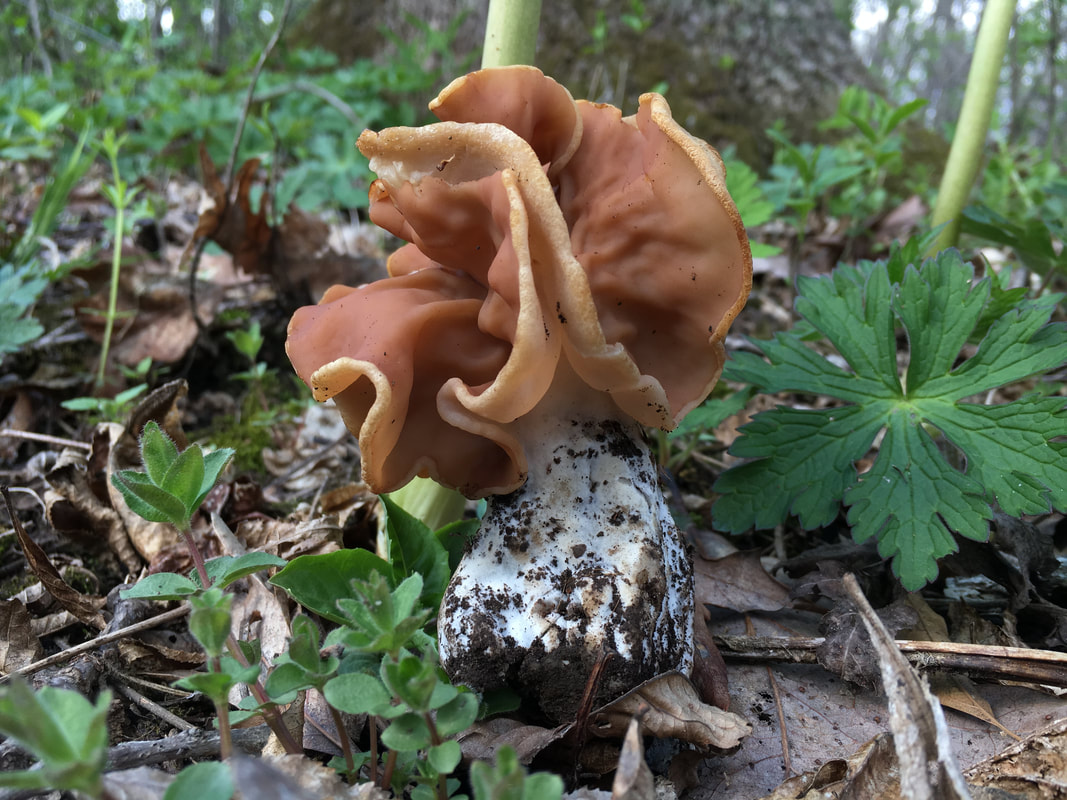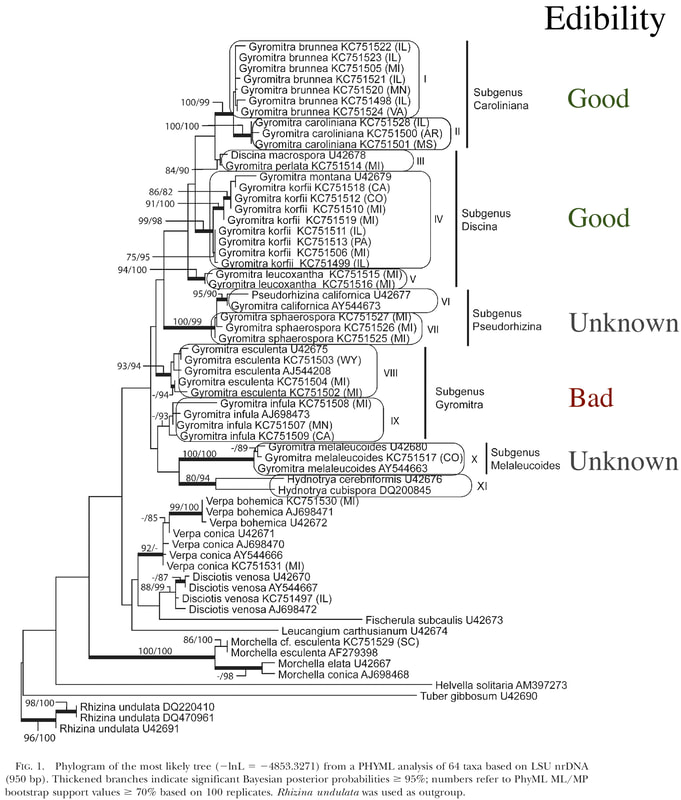|
Mycobank Taxonomy: Fungi, Dikarya, Ascomycota, Pezizomycotina, Pezizomycetes, Pezizales, Discinaceae, Gyromitra Elephant ears lorchel is the most common Gyromitra species in Wisconsin. It grows as a saprotroph and possibly as a mycorrhizal fungus with oaks. You can find it fruiting during morel season along with other spring ascomycetes such as the scarlet cup and devil's urn. These mushrooms can get huge, which is all the more reason to wonder, can I eat them? Confusion and uncertainty reigns about the edibility of this species and other Gyromitra mushrooms. In field guides, Gyromitra is universally labeled as poisonous, even deadly. However, other sources suggest a much more nuanced picture. For those who are new to the issue, some Gyromitra species, particularly Gyromitra esculenta, contain gyromitrin, a chemical that is hydrolized to monomethlyhydrazine when consumed or heated. Monomethylhydrazine is also used as a propellant for rockets and is dangerously toxic and carcinogenic. Gyromitra is perhaps one of the few fungi with the distinction of being poisonous not only through direct consumption but also through inhalation of its cooking fumes. It would seem clear cut: these fungi contain known carcinogens in significant quantities to cause documented deaths, especially in Europe - don't eat them! Yet, in Finland, the most toxic of the Gyromitra species, G. esculenta, is sold in markets and consumed by the public through a double parboiling method. Here in the United States, Gyromitra esculenta and closely related species should probably be avoided, but a whole suite of other Gyromitra species seem safe enough to eat and are "probably no more dangerous to consume than Morchella species" according to Michael Beug, North American ascomycete expert. After reading through Forager Chef's detailed post on eating false morels, I felt ready to try them for myself. While parboiling would not be necessary for Gyromitra species with very small quantities of gyromitrin, I opted to double parboil as if I were in Finland eating Gyromitra esculenta, just to be safe. My skepticism turned into paranoia and I ended up double parboiling the poor mushroom for about 40 minutes total before dabbing it dry and frying it in a pan. By that point, it looked like something biological that had been collected in the 19th century and preserved in a jar of formaldehyde for all this time. There wasn't much taste left in it, although the crispy texture was great. I couldn't get the image of preserved tissues out of my brain and ate only half of what I cooked. For the adventurous eaters and risk takers, all the anecdotes and expert evidence suggests that Gyromitra brunnea is a fine edible when cooked thoroughly. Forager Chef recommends frying the mushroom whole, but I suggest cutting it into pieces like normal so that the cooking and texture is even across the mushroom. Personally, I will not be trying this mushroom again until I can gain some reassurance that it doesn't pose longterm health problems through the cumulative effects of rocket fuel. In all cases, safe consumption begins with knowing what you are actually eating. Make sure you can confidently distinguish the different Gyromitra species before consuming any of them. SpecimenACD0141, 4 May 2019; Dane Co., WI, USA; leg. Alden C. Dirks, det. Alden C. Dirks, GenBank –– (ITS rDNA), MICH 352018. ReferencesBeug, M. W. (2014). False morels: Age-old questions of edibility. FUNGI, 28–31. Methven, A. S., Zelski, S. E., & Miller, A. N. (2013). A molecular phylogenetic assessment of the genus Gyromitra in North America. Mycologia, 105(5), 1306–1314. https://doi.org/10.3852/12-397 Online Resources
0 Comments
Your comment will be posted after it is approved.
Leave a Reply. |
PermalinksProject Introduction Top EdiblesHericium coralloides
Laetiporus sulphureus Morchella americana Polyporus umbellatus Suillus ampliporus Archives
April 2023
Categories |
|
|
Terms of Use, Liability Waiver, and Licensing
The material on aldendirks.com is presented for general informational and educational purposes only, and under no circumstances is to be considered a substitute for identification of an actual biological specimen by a person qualified to make that judgment. Some fungi are poisonous; please be cautious. All images on this website are licensed under Attribution-NonCommercial-NoDerivatives 4.0 International (CC BY-NC-ND 4.0). |


 RSS Feed
RSS Feed




